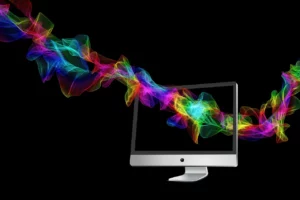Content streaming has become the core of entertainment throughout the globe today. From the mini screens of mobile phones to substantial display screens, the history of monitor and display technology has come a long way.
We have witnessed the advent of advanced and sophisticated hardware inventions and innovations that have significantly boosted monitor technology. The introduction of better streaming technology and hardware has also changed the face of monitors worldwide.
Currently, the world possesses the most extraordinary monitors supporting real-life-like images and visuals. The article below attempts to trace this impressive history of monitors, from simple cathode ray tubes to OLEDs.

What is the History of Monitor Technology?
The history of monitor technology spans several eras, each characterized by the prominence of one or more display technologies. The section below categorizes each significant period in the history of monitors based on the prominent technology used in them.
1. Cathode Ray Tubes
German physicists Johann Wilhelm Hittorf and Julius Plucker are credited with the invention of cathode rays in 1869. Based on the invention of cathode rays, an early display tool called the cathode ray tube was invented afterward in 1897 by another German physicist and scientist, Karl Ferdinand Braun.
CRT is composed of a vacuum tube that has electron guns equipped in it. The vacuum tube is lined with a fluorescent screen. The electron guns emit fats moving electrons that hit on this fluorescent screen that creates appropriate images.
It was only in 1907 that the invention was made to incorporate cathode ray tubes into television screens to display images. This invention was made by a Russian scientist named Boris Rosing. By 1922, this famous invention was commercialized. Soon, cathode ray tubes took over global television screens and monitor technology.
Cathode ray tubes were popular until the second half of the 20th century. By this time, cathode ray tubes had undergone numerous changes and earned an excellent reputation in the industry.
2. Plasma Display
The concept of a plasma display system was first introduced in theory by Hungarian engineer Tihanyi in 1936. This technology was later developed into a functioning unit by Donald Bitzer, Robert Willson, and Gene Slottow in 1964.
The plasma display technology uses mercury vapor, inert gases, and a vacuum tube. Based on the pixel used, the vacuum tubes can produce various colored lights.
Plasma became the top-rated technology during and until the early 2000s due to the higher clarity images produced. Their only downside was their incapability to integrate into smaller screens. This downside caused the plasma display technology to lose its upper hand in the market.
3. Liquid Crystal Display
Austrian scientist Friedrich Reinitzer discovered liquid crystals in 1888. But it was only in 1962 that scientist Richard Williams discovered the scope of liquid crystals in display technology. He identified that liquid crystals can form patterns when excited with an electric field.
In 1968, George H Heilmeier integrated liquid crystals into display technology and created the first LCD or liquid crystal display unit. LCD features an LCD cell placed between a couple of glass substrates.
Right after its invention in 1968, LCD became immensely popular in monitor technology. It minimized the size of LCD to integrate into all kinds of devices, including clocks, watches, calculators, and many more.
Even today, LCD technology has a great fan following around the world. This technology has several highlighting features like low power consumption, lightweight build, relatively smaller size, etc., making it more popular than its counterparts. LCD screens have now become a popular choice when purchasing televisions and computers.

4. LED
The invention of the first LED light happened in the year 1962 by engineer Nick Holonyack. After voracious research from 1962 to 1968, a team at Hewlett Packard Company developed the first LED device, a calculator with an LED display.
The Hewlett Packard company soon commercialized the LED technology, which literally revolutionized the entire monitor and display technology industry. LED monitors were known for their vivid display, better contrast, etc.
5. OLED
OLED came into existence as an improvised successor to LED technology. OLED, or Organic Light Emitting Diode, was developed in 1987 by Steven Van Slyke and Deng Qingyun.
OLED devices, especially monitors, are noted for quick response time, wide viewing angles, etc. OLED is more flexible, smaller, and thinner than LED, LCD, and many other monitor technologies. These features enable manufacturers to use OLED in almost all display devices like computers, television, mobile phones, etc.
OLED is considered the future of display technology due to multiple reasons. The flexibility of the technology enables it to be used in innovative concepts like curvedmonitors, flexible screens, and many more.
What is the Use of a Cathode Ray Tube Monitor?
- The user need not rescale the images as they operate at any aspect ratio and resolution.
- Cathode ray tube monitors have one of the highest pixel resolutions currently available.
- They feature a great grey and color scale with a large number of intensity levels.
- The contrast levels are excessively high with these monitors. So, it is ideal for displaying images even in the darkest environments.
- The cathode ray tube monitors respond much quicker than most of their counterparts. So, these are great for exhibiting faster-paced images and visuals.
- Cathode-ray tube monitors cost much less than many available display technologies.
Future Prospects for Monitor Technology
Monitor technology is undoubtedly one of the fastest-growing industries globally. Although the sections above prominently discuss the industry’s growth from cathode ray tubes to OLEDs, monitor technology has been introducing even novel technologies like Gyricon, electric paper, and Digital Light Processing (DLP) display technology.
Introducing such advanced technology brings about a greater scope and future for monitor technology. The advancements in manufacturing processes, research on new materials, etc., will undoubtedly improve what the current monitor technologies have got to offer.
In the future, monitor technology will be experiencing changes and improvements in terms of screen resolution, real-life-like image projection, form, and build, etc.
Also, advancing technology in all phases of science and introducing the latest hardware equipment will surely bring about better milestones in the future evolution of monitor technology.

Summary
Monitor technology boasts of a rich history that began with the introduction of cathode ray tubes in 1897. The journey of monitor technology went through multiple eras, each showing the rise of various display technologies like plasma display, LCD, LED, and OLED.
Although LCD, LED, and OLED are the prominent players currently, researchers are still proceeding to bring even better options for display devices. Some of the latest additions include Gyricon, DLP technology, etc. With the advancement in technology and hardware equipment, the future of monitor technology seems brighter than ever.
FAQs
1. Which technology was used in the first-generation monitors?
The first-generation monitors prominently used the cathode ray tube technology. It was only after several decades that cathode ray tubes were replaced by LCDs and other technologies.
2. When did LCD monitors replace CRT?
LCD monitors started replacing CRTs from the late 90s onwards. By the second half of 2000, the replacement was almost complete.

